写信作文指导ppt
- 格式:pptx
- 大小:271.45 KB
- 文档页数:16

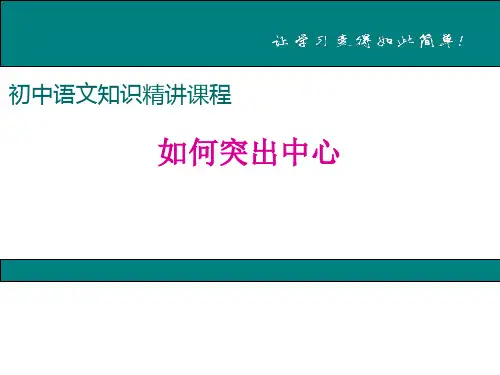
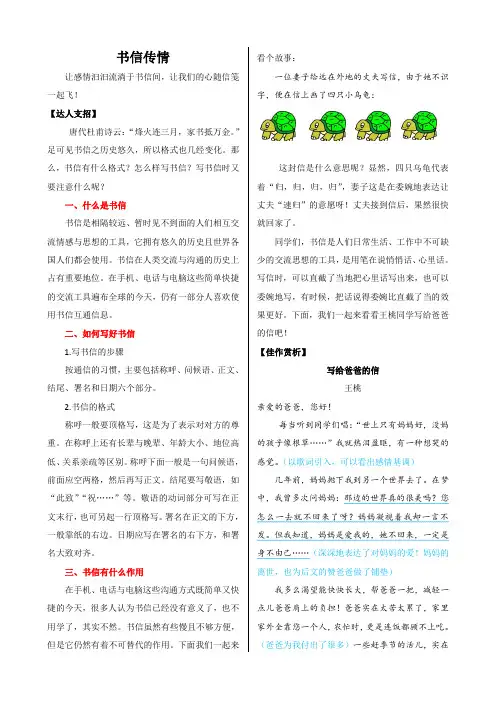
书信传情让感情汩汩流淌于书信间,让我们的心随信笺一起飞!【达人支招】唐代杜甫诗云:“烽火连三月,家书抵万金。
”足可见书信之历史悠久,所以格式也几经变化。
那么,书信有什么格式?怎么样写书信?写书信时又要注意什么呢?一、什么是书信书信是相隔较远、暂时见不到面的人们相互交流情感与思想的工具,它拥有悠久的历史且世界各国人们都会使用。
书信在人类交流与沟通的历史上占有重要地位。
在手机、电话与电脑这些简单快捷的交流工具遍布全球的今天,仍有一部分人喜欢使用书信互通信息。
二、如何写好书信1.写书信的步骤按通信的习惯,主要包括称呼、问候语、正文、结尾、署名和日期六个部分。
2.书信的格式称呼一般要顶格写,这是为了表示对对方的尊重。
在称呼上还有长辈与晚辈、年龄大小、地位高低、关系亲疏等区别。
称呼下面一般是一句问候语,前面应空两格,然后再写正文。
结尾要写敬语,如“此致”“祝……”等。
敬语的动词部分可写在正文末行,也可另起一行顶格写。
署名在正文的下方,一般靠纸的右边。
日期应写在署名的右下方,和署名大致对齐。
三、书信有什么作用在手机、电话与电脑这些沟通方式既简单又快捷的今天,很多人认为书信已经没有意义了,也不用学了,其实不然。
书信虽然有些慢且不够方便,但是它仍然有着不可替代的作用。
下面我们一起来看个故事:一位妻子给远在外地的丈夫写信,由于她不识字,便在信上画了四只小乌龟:这封信是什么意思呢?显然,四只乌龟代表着“归,归,归,归”,妻子这是在委婉地表达让丈夫“速归”的意愿呀!丈夫接到信后,果然很快就回家了。
同学们,书信是人们日常生活、工作中不可缺少的交流思想的工具,是用笔在说悄悄话、心里话。
写信时,可以直截了当地把心里话写出来,也可以委婉地写,有时候,把话说得委婉比直截了当的效果更好。
下面,我们一起来看看王桃同学写给爸爸的信吧!【佳作赏析】写给爸爸的信王桃亲爱的爸爸,您好!每当听到同学们唱:“世上只有妈妈好,没妈的孩子像根草……”我就热泪盈眶,有一种想哭的感觉。
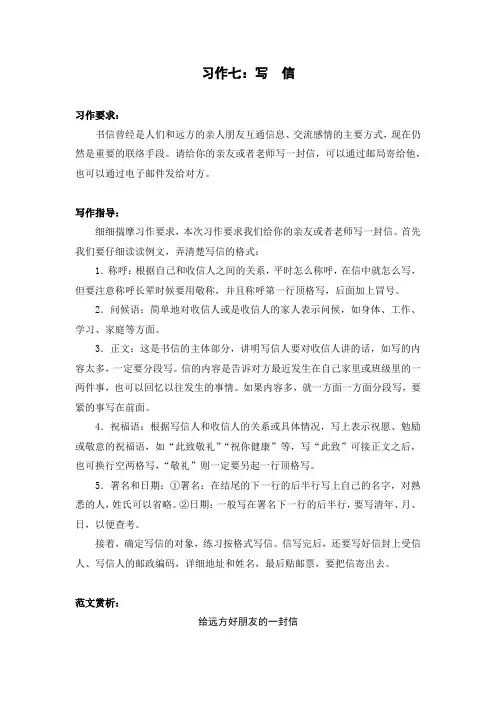
习作七:写信习作要求:书信曾经是人们和远方的亲人朋友互通信息、交流感情的主要方式,现在仍然是重要的联络手段。
请给你的亲友或者老师写一封信,可以通过邮局寄给他,也可以通过电子邮件发给对方。
写作指导:细细揣摩习作要求,本次习作要求我们给你的亲友或者老师写一封信。
首先我们要仔细读读例文,弄清楚写信的格式:1.称呼:根据自己和收信人之间的关系,平时怎么称呼,在信中就怎么写,但要注意称呼长辈时候要用敬称,并且称呼第一行顶格写,后面加上冒号。
2.问候语:简单地对收信人或是收信人的家人表示问候,如身体、工作、学习、家庭等方面。
3.正文:这是书信的主体部分,讲明写信人要对收信人讲的话,如写的内容太多,一定要分段写。
信的内容是告诉对方最近发生在自己家里或班级里的一两件事,也可以回忆以往发生的事情。
如果内容多,就一方面一方面分段写,要紧的事写在前面。
4.祝福语:根据写信人和收信人的关系或具体情况,写上表示祝愿、勉励或敬意的祝福语,如“此致敬礼”“祝你健康”等,写“此致”可接正文之后,也可换行空两格写,“敬礼”则一定要另起一行顶格写。
5.署名和日期:①署名:在结尾的下一行的后半行写上自己的名字,对熟悉的人,姓氏可以省略。
②日期:一般写在署名下一行的后半行,要写清年、月、日,以便查考。
接着,确定写信的对象,练习按格式写信。
信写完后,还要写好信封上受信人、写信人的邮政编码,详细地址和姓名,最后贴邮票,要把信寄出去。
范文赏析:给远方好朋友的一封信亲爱的一帆同学:你好吗?我们有幸在一次旅游的途中相遇,并成了一对好朋友。
上次你在信中说非常想知道我的家乡是什么样子的,现在就让我来告诉你吧:它没有车水马龙的繁华,没有人流如织的热闹,有的是小村庄的宁静和独特的田园景色。
我们村里有一片肥沃的土地。
春天到了,金黄的油菜花开了,常有蜜蜂来这里采花酿蜜,还有成群结队的蝴蝶仙子来这里翩翩起舞。
人们从这里路过时总会忍不住放慢脚步,不知是被美景陶醉,还是怕打扰了蝴蝶、蜜蜂独享的快乐。
![高考复习作文指导ppt[优秀课件资料]](https://uimg.taocdn.com/57a7886dcc7931b764ce155f.webp)
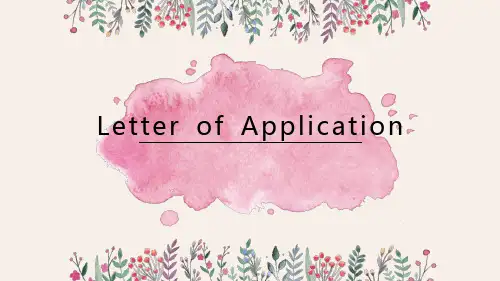
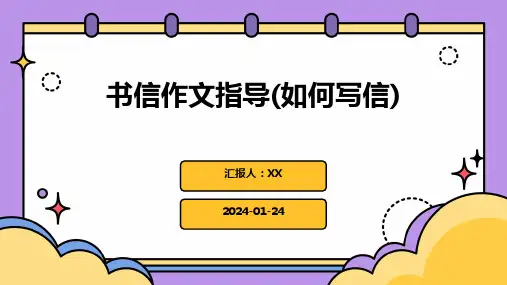



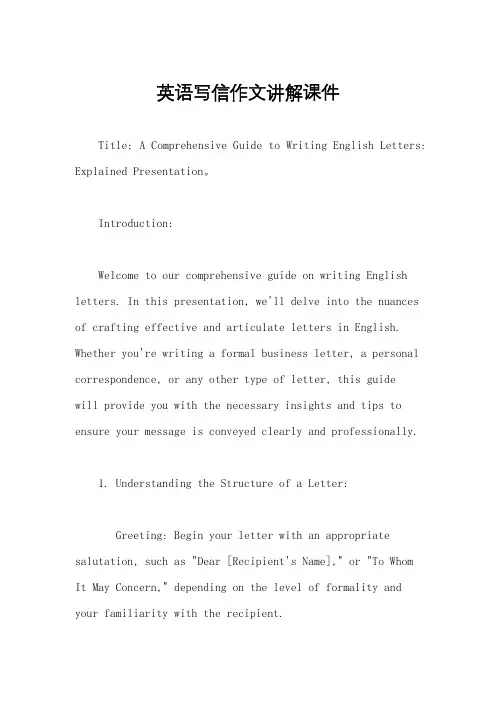
英语写信作文讲解课件Title: A Comprehensive Guide to Writing English Letters: Explained Presentation。
Introduction:Welcome to our comprehensive guide on writing English letters. In this presentation, we'll delve into the nuances of crafting effective and articulate letters in English. Whether you're writing a formal business letter, a personal correspondence, or any other type of letter, this guidewill provide you with the necessary insights and tips to ensure your message is conveyed clearly and professionally.1. Understanding the Structure of a Letter:Greeting: Begin your letter with an appropriate salutation, such as "Dear [Recipient's Name]," or "To WhomIt May Concern," depending on the level of formality and your familiarity with the recipient.Body: The body of the letter comprises the main content, where you express your thoughts, concerns, requests, or any other relevant information. Organize your ideas logically and coherently, using paragraphs to separate different points.Closing: Conclude your letter with a courteous closing, such as "Sincerely," "Best regards," or "Yours faithfully," followed by your signature and printed name.2. Tips for Effective Communication:Clarity: Use clear and concise language to convey your message effectively. Avoid using overly complex words or phrases that may confuse the reader.Tone: Consider the tone of your letter, and adapt it to suit the purpose and audience. Whether formal or informal, maintain a respectful and professional tone throughout.Politeness: Always be polite and courteous in your language and tone. Thank the recipient for their time and consideration, and avoid any language that could be perceived as rude or offensive.Proofreading: Before sending your letter, carefully proofread it for grammar, punctuation, and spelling errors.A well-written and error-free letter reflects positively on your professionalism and attention to detail.3. Types of Letters and Their Formats:Formal Letters: Used for business communication, job applications, inquiries, etc. Follow a standard format with a formal tone and language.Informal Letters: Used for personal communication with friends, family, or acquaintances. Can be more casual in tone and language.Business Letters: Include elements such as the sender's address, date, recipient's address, subject line,salutation, body, closing, and signature.Personal Letters: Generally omit the sender's address and include a more personal salutation and content.4. Sample Letter Templates:Formal Business Letter Template:[Include a sample template with placeholders for sender's address, recipient's address, date, subject line, salutation, body, closing, and signature.]Informal Personal Letter Template:[Include a sample template with placeholders for date, recipient's name, salutation, body, closing, and sender's name.]Conclusion:In conclusion, mastering the art of writing Englishletters is essential for effective communication in various contexts. By understanding the structure, tone, and conventions of different types of letters, you can confidently express your thoughts and ideas while maintaining professionalism and courtesy. We hope this guide has been helpful in enhancing your letter-writing skills. Thank you for your attention, and happy writing![End of Presentation]。